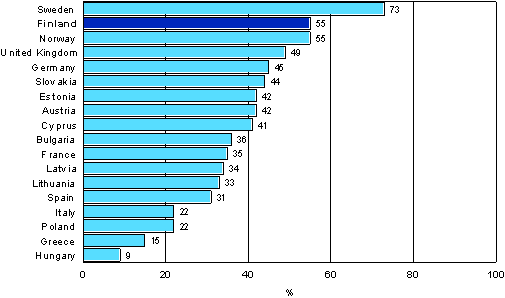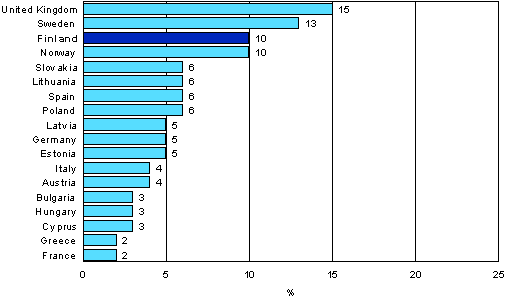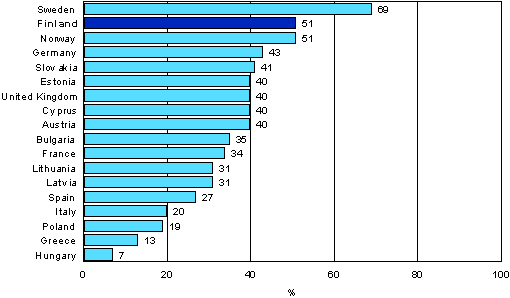2. Participation of the adult population in education and training
2.1 Participation in formal or non-formal education and training
Figure 1. Participation in formal or non-formal education and training during 12 months in selected European countries over the years 2005-2007 (population aged 25-64)

In the Nordic and Baltic countries, women were typically more active than men in educating and training themselves. The participation rate of women was higher than that of men also in the United Kingdom. However, in Austria, Bulgaria, Cyprus, Germany and France, men participated in formal or non-formal education and training more often than women.
In all the comparison countries, persons with a tertiary-level degree have participated in formal or non-formal education and training much more often than persons with primary or secondary education (Annex Table 1). In Sweden, persons aged 25 to 64 with all levels of basic education participated in education and training more often than others. Even among those Swedes who have only completed primary school, more than half participated in education and training during the survey year. It is notable that their participation rate (56 per cent) is as high as that of all persons aged 25 to 64 in Finland and Norway on average. In all countries other than Hungary and Greece, the participation rate of persons with a tertiary-level degree was over 50 per cent.
In the countries with the highest participation rate in formal or non-formal education and training (the Nordic countries and the United Kingdom), the differences in the participation rates of persons with different levels of basic education were lowest in relative terms. The same trend can also be observed at the other end of the scale, i.e. in Poland, Greece and Hungary, where participation was lowest; here the relative differences in participation rates were the greatest. Therefore, a high participation rate would seem to increase equality in education and training.
In all the comparison countries, persons aged 55 to 64 participated in formal or non-formal education and training less often than those in the other age groups. The relative differences in participation rates between countries were also greater in this age group, than in other age groups. For example, while around six out of 10 persons aged 55 to 64 living in Sweden participated in education and training during the survey year; in Hungary, only 3 per cent of persons aged 55 to 64 participated. In nearly all the countries, persons aged 25 to 34 participated in education and training the most, though in some countries, persons aged 35 to 54 participated almost as often.
In all the comparison countries, employed persons participated in formal or non-formal education and training more often than unemployed persons and persons outside the labour force. Unemployed persons participated in education and training more often than persons outside the labour force everywhere except in Finland and Bulgaria, where these groups participated in education and training equally often. The largest relative differences in the participation rates of the labour market status groups were in Bulgaria, Slovakia and Lithuania, while the smallest relative differences were in Sweden, Austria and Norway. Therefore, the observation that a high participation rate implies a certain equality in education and training cannot be made as easily between persons with different labour market statuses as it can between the various levels of basic education.
Persons aged 25 to 64 living in urban and semi-urban areas participated in formal or non-formal education and training more often than those living in rural areas in nearly all the comparison countries. The exceptions were Germany, where persons living in rural and urban areas participated in education and training more often than those living in semi-urban areas, and the United Kingdom, where the classification of the municipality of residence did not affect the rate of participation in education and training. However, the differences in the rate of participation in education and training by type of municipality of residence were relatively small. For example, the differences in participation rates between the inhabitants of urban and rural communities exceeded 10 per cent only in Cyprus, Lithuania, Norway and Poland.
2.2 Participation in formal education and training
During the survey year, persons aged 25 to 64 living in the United Kingdom and the Nordic countries were clearly the most active participants in formal education and training, i.e. education and training that leads to a qualification (Figure 2). In the United Kingdom, around one in seven persons studied with the aim of acquiring a qualification, in Sweden around one in eight, and in Finland and Norway around one in 10.
In Finland, the majority, or 70 per cent, of education and training that leads to a qualification in this age group is education and training that leads to a tertiary degree. Around one in three persons aged 25 to 64 who participated in formal education and training identified studying as their principal activity.
Figure 2. Participation in formal education and training during 12 months in selected European countries over the years 2005-2007 (population aged 25-64)

It was typical for women in the United Kingdom and the Nordic countries to participate in formal education and training more often than men (Annex Table 2). In Sweden, women’s participation rate (16 per cent) was six percentage points higher than the corresponding figure for men. In the United Kingdom, women led by five percentage points, and in Finland and Norway, they led by four percentage points. It was also more common for women to participate than men in Slovakia and the Baltic countries (Estonia, Latvia, Lithuania). On the other hand, men in Cyprus and Germany participated in education and training that leads to a qualification more often than women.
Persons with a tertiary degree participated in formal education and training somewhat more often than others in all countries other than Finland, where their participation rate was almost the same as that of persons with a secondary degree (persons with a tertiary degree 13%, persons with a secondary degree 12%). The differences in the participation rates of persons with basic-level education of different lengths were especially great in Cyprus, France, Lithuania, Latvia and Poland. In all of these countries, the rate of participation in formal education and training by persons with a tertiary degree was at least three times the participation rate of persons with a secondary degree, for example.
In all the countries included in the survey, persons aged 25 to 34 were clearly the most active when it came to participating in education and training that leads to a qualification. Persons aged 35 to 54 living in the United Kingdom and Sweden participated in formal education and training more often than persons of the same age in other countries. In the United Kingdom, the participation rate for this age group was 15 per cent and in Sweden it was 11 per cent. In the other countries, the participation rates varied between one and nine per cent. In the oldest age group, 55 to 64, persons living in the United Kingdom were clearly more active in participating in formal education and training. Of these, around 8 per cent studied with the aim of obtaining a degree during the study year, whereas in the other comparison countries, the participation rates ranged between zero and three per cent.
Labour force status affects participation in formal education and training in different ways in different countries. In the Nordic countries, for example, persons outside the labour force were the most active in participating in education and training. The situation was the same in Bulgaria and Germany. However, in a number of former Eastern Bloc countries (Hungary, Latvia, Lithuania, Poland) and the United Kingdom, employed persons were the most active in participating in formal education and training. In Italy and Cyprus, unemployed persons participated in education and training that leads to a qualification more often than employed persons and persons outside the labour force.
In nearly all the countries, residents of urban areas participated in formal education and training more frequently than others. The exceptions are Bulgaria, where residents of semi-urban areas participated the most and Hungary, Lithuania and Norway, where residents of urban areas and semi-urban areas were equally as active in studying with the aim of obtaining a degree.
2.3 Participation in non-formal education and training
The highest rate of participation in non-formal education and training (that does not lead to a qualification) was in the Nordic countries (Figure 3). People participated in this kind of education and training clearly more often in Sweden than in the other countries. Among the persons living there aged 25 to 64, around seven in 10 people studied for reasons other than to obtain a degree. In Finland and Norway, around one in two participated in such education and training. The participation rate also exceeded 40 per cent in Germany and Slovakia. The lowest participation rates in education and training that does not lead to a qualification were in Hungary, Greece and Poland. In these countries, the participation rate remained below 20 per cent and, in the case of Hungary, even below 10 per cent.
Figure 3. Participation in (non-formal) education and training that does not lead to a qualification during 12 months in selected European countries over the years 2005-2007 (population aged 25-64)

In Finland and the Baltic countries, women generally participated in non-formal education and training much more frequently than men (Annex Table 3). In Finland, the difference was approximately 12 percentage points in favour of women, while in Estonia, Lithuania and Latvia the difference ranged from eight to 12 percentage points. In four countries (Austria, Cyprus, Germany and Slovakia) men participated in this kind of education and training slightly more often than women: the differences in the participation rates were between four and five percentage points. In most countries, the differences between the sexes in rates of participation in non-formal education and training were negligible.
In all the comparison countries, persons who have a tertiary-level degree participated much more frequently than others in education and training that does not lead to a qualification. If we compare the participation rates of persons who have a tertiary-level diploma with those of people who have completed only primary-level education, we can note that the relative differences are greatest in Greece, Hungary, Italy, Lithuania and Poland. In all these countries, the participation rate of persons who have a tertiary-level diploma was at least five times higher than the participation rate of those who have completed only primary-level education, and the figure is 12 times as high in Poland. Norway, Sweden and the United Kingdom were the only countries in which this relative difference in participation rates between persons who have a tertiary-level degree and those who have completed only primary-level education was less than double.
In all the comparison countries, persons aged 55 to 64 were the least active participants in education and training that does not lead to a qualification. In six countries (Cyprus, France, Greece, Hungary, Italy and Poland), the participation rate of this oldest age group was less than half that of persons aged 25 to 54. Among persons aged 55 to 64, those living in Sweden were by far the most active participants in non-formal education and training. In Sweden, around six people in 10 in this age group participated in education and training during the survey year, while in Norway and Sweden, around four people in 10 in this age group participated. In the oldest age group, participation was lowest in Hungary (3 per cent), Greece (5 per cent) and Poland (7 per cent).
In most of the comparison countries, no difference was discernible between in the participation in non-formal education and training by persons aged 25 to 34 and persons aged 35 to 54.
In all the comparison countries, employed persons participated significantly more often than others in education and training that does not lead to a qualification. Moreover, in nearly all the countries, the participation rate of unemployed persons was higher than that of persons outside the labour force. The relative difference in the rates of participation in non-formal education and training between employed persons and unemployed persons was greatest in Bulgaria and Slovakia. In Bulgaria, the participation rate of employed persons was eight times as high as the participation rate of unemployed persons, while in Slovakia the rate was four times as high.
In most of the comparison countries, persons aged 25 to 64 living in urban or semi-urban areas participated more than average in education and training that does not lead to a qualification. A notable exception is Germany, where residents of rural communities were the most active participants in education and training. In Austria, Bulgaria, Estonia, Latvia and the United Kingdom, the residents of semi-urban areas participated the most in education and training that does not lead to a qualification. In Spain, Hungary and Sweden the type of municipality of residence had no bearing on the rate of participation in education and training.
Source: EU Adult Education Survey, Eurostat
Inquiries: Timo Ruuskanen (09) 1734 3620, Irja Blomqvist (09) 1734 3221
Director in charge: Riitta Harala
Updated 24.4.2009
Official Statistics of Finland (OSF):
Participation in adult education [e-publication].
ISSN=2489-6926. European comparison 2006,
2. Participation of the adult population in education and training
. Helsinki: Statistics Finland [referred: 28.12.2025].
Access method: http://stat.fi/til/aku/2006/04/aku_2006_04_2009-04-24_kat_002_en.html

